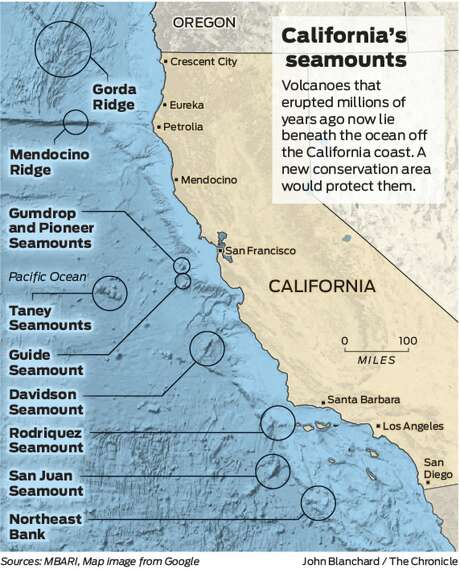Undersea Habitats need Protection, Legislator Says
Published on July 29th, 2016
By David Perlman
July 28, 2016
San Francisco Chronicle
On the Davidson seamount, A basket starfish perches on a Picasso sponge. Photo: MBARI/NOAA
A chain of undersea volcanoes that erupted millions of years ago off the California coast harbors such a rich variety of animal life and clues to the seabed’s turbulent past that new legislation to protect them is awaiting its time in Congress.
Known as seamounts, many of these long-extinct mountains rise more than 2 miles, yet their summits lie more than 1,000 feet beneath the ocean surface.
Scientists investigating them have found that their summits form thriving habitats for countless species of juvenile fish, while their rock-studded flanks are home to a riot of deep-water corals, giant sponges and bizarre organisms still unclassified. The cold, dark ocean currents swirling around them carry upwelling food for endangered seabirds.
On one undersea mountain range called the Gorda Ridge northwest of California’s Cape Mendocino, long-ago dredging found signs of valuable minerals. The discoveries led to an Interior Department proposal — later abandoned — to lease nearly 70,000 square miles of the deep-sea ridge to mining companies seeking metals like gold, silver, copper and zinc.
Federal legislation introduced last week by Rep. Sam Farr, D-Carmel, would create a conservation area to protect the undersea volcanoes that lie within the traditional 12-mile offshore boundary. His bill cites their “remarkably pristine condition, limited human footprint, and reputation as a vital frontier for scientific discovery.”

Farr said the bill, which had not yet been assigned a number, was prompted by the possibility of “eventual commercial interests.” And because many seamounts lie within known fisheries, the bill would ensure that commercial fishermen are involved when regulations are written to govern access to the areas, he said.
Scientists aboard the research vessel Western Flyer, from the Monterey Bay Aquarium Research Institute, sailed Tuesday from Moss Landing on a brief mission to Gorda Ridge, where they will probe its tumultuous geology and study the giant tube worms, the strange clams and the heat-loving microbes that abound around it.
As on earlier seamount explorations, the science team will use the institute’s remotely operated submarine to probe the volcanic rocks and gather samples of the ridge’s life forms. The sub is named Doc Ricketts for the real-life marine biologist in many of John Steinbeck’s novels.
One of the largest undersea volcanoes in the world is the Davidson Seamount, about 80 miles southwest of Monterey, which has been extinct for more than 9 million years and is now part of the Monterey Bay National Marine Sanctuary. Its six parallel rocky ridges and sediment-filled valleys formed about 12 million years ago atop what was then a long seismic fault.
“It is now a unique congregating place for fish of every kind, for fin whales and sperm whales, and a feeding ground for elephant seals,” said Andrew de Vogelaere, a marine biologist and the sanctuary’s research coordinator. “It’s a hot spot of biodiversity.”
Lonny Lundsten, an aquarium research institute biologist, described the Davidson Seamount as a rich, old-growth forest of animals.
“There are giant sponges and deep-water bubblegum corals 9 feet tall, that have probably been alive for more than 200 years,” he said.
Lundsten recently discovered four new species of carnivorous sponges that dine on an abundance of tiny shrimp-like crustaceans called amphipods and copepods, and he expects that more will be found as scientists continue exploring the seamounts.





